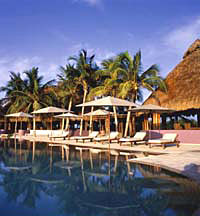 |
 |
 |
 Travel & Outdoors | April 2005 Travel & Outdoors | April 2005  
The New Venice of Mexico
 Ken Becker - Canadian Press Ken Becker - Canadian Press


| | A unique resort village is being carved out of the jungle on Mexico's Mayan Riviera. (CP Photo) |
A unique resort village is being carved out of the jungle on Mexico's Mayan Riviera.

Named Mayakoba - "city on water" in Mayan - the nearly $2-billion project's partners include a handful of luxury hotel brands, sharing 240 hectares bordering a 1.6-kilometre stretch of the Caribbean.

But, instead of erecting towers along the beachfront, like Cancun, 70 kilometres to the north, Mayakoba's low-rise structures will blend into the jungle, connected to each other and the nearby sea by a network of freshwater channels. Water taxis, called lanchas, will be the main mode of transportation - no cars are allowed - within a tropical refuge that is also home to hundreds of species of birds and animals.

"We really think the environment is the key to Mayakoba," the director of the development, Juan Aguilar, says from the site. "The lagoons and canal system are the very essence of Mayakoba."

The transformation of raw jungle into upscale resort - the first hotel, a Fairmont, opens later this year - can be traced to the late 1980s, when the giant Spanish construction firm OHL purchased the property. This was a time when the nearby town of Playa del Carmen was just starting to become a tourist destination.

But it was also when the Mexican government began imposing tough environmental restrictions on development of this seashore on the Yucatan Peninsula, especially to protect the sand dunes and mangroves that form a natural barrier between the saltwater and the jungle.

OHL's plan, later accepted by the government, was to construct most of the resort inland - with a limited number of beachfront cottages - preserving the dunes and the mangrove.

"It was risky bringing the hotels away from the beach," says Aguilar, explaining the challenge of selling the concept to hoteliers. But the lure became the promise of creating Venice on the Caribbean, the romance of the lagoons and canals - underground rivers unearthed and sculpted in the limestone bedrock - and the wooden lanchas shaded by a roof of thatched palm fronds.

"Guests can phone from their suites and a water taxi will pick them up at their dock, with a glass of champagne, and take them wherever they want to go," says Aguilar.

The choices of where to go also make this resort different. All guests will be welcome at all the hotels' golf courses - at least one more is planned - spas, restaurants, bars and beach clubs.

The five hotels, now in various stages of construction - a sixth is expected, with the entire project scheduled to be completed by 2008 - are:

• The Fairmont Mayakoba, with 401 rooms, including casitas overlooking the dunes, is scheduled to open in December. Its Willow Stream spa has treetop treatment areas. Toronto-based Fairmont will also manage the 18-hole golf course, called El Camaleon, designed by Greg Norman. Dining options range from a market-cafe to Las Brisas, an oceanside restaurant specializing in seafood.

• Laguna Kai, run by Dallas-based Rosewood Hotels and Resorts, plans to receive its first guests next year. It will have 120 waterfront rooms, with private docks and gardens, plunge-pools and outdoor showers. Its spa is on an island. Gourmet treats will be imported from New York's famous Dean and Deluca .

• The latest entry from Singapore-based Banyan Tree Hotels and Resorts is scheduled to open in 2007, bringing its Asian influence to the Caribbean. All 120 villas will have private pools, outdoor baths and meditation areas. Its Saffron restaurant will be on pontoons in a lagoon. A gallery promoting local artisans will sell silver, pottery and other crafts.

• The Viceroy Mayakoba, from the Los Angeles-based Kor Hotel Group, is also forecasting a 2007 opening, with 110 villas: 70 overlooking lagoons and the golf course, and 40 on the coast.

• La Casa Que Canta, the renowned retreat at Zihuatanejo on Mexico's Pacific coast, plans its Mayakoba debut in 2008.

Resort guests arriving at Cancun airport, about 40 minutes away, will have the option of taking a shuttle bus to their hotel or renting a car. Since there are no roads for motor vehicles at Mayakoba - only trails for golf carts, cycling and walking - a car will be needed only to explore such nearby attractions as the Mayan ruins at Coba and Chichen Itza, the diving mecca of Cozumel, and shopping and nightlife in Playa del Carmen.

Or, visitors can simply camp at the resort and hang out with the locals, which include monkeys, wild cats called jaguarundis, flamingos and pelicans. About half a dozen endangered manatees are being imported and granted safe haven in the lagoons and canals.

Any resident crocodiles that prove bothersome will be exported, Aguilar says.

For more information: www.mayakoba.com, follow the links to the five hotels to check opening dates and rates. | 
 | |
 |



